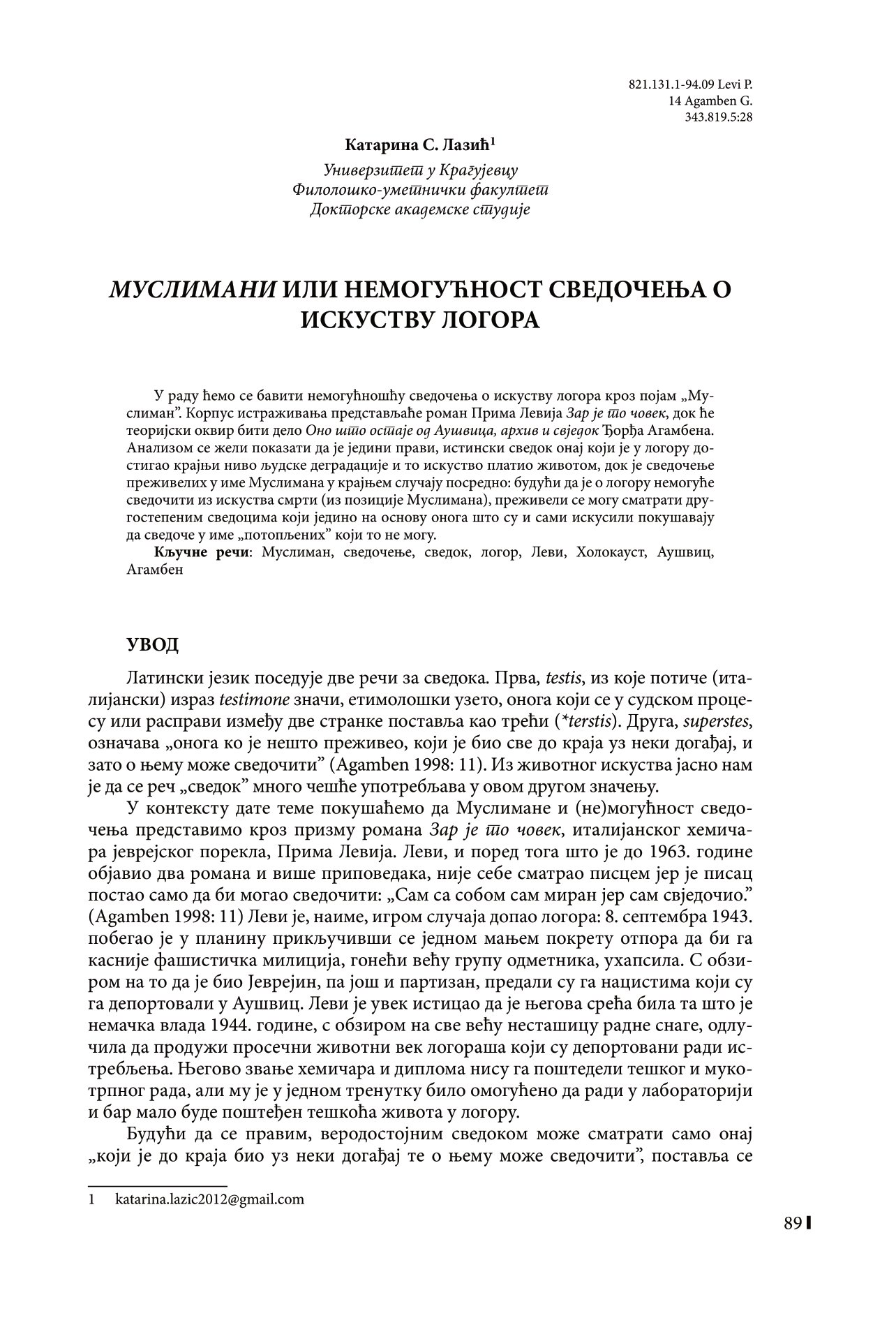Приказ основних података о документу
"Muslimani" ili nemogućnost svedočenјa o iskustvu logora
The "Muslim" or the impossible witness
| dc.contributor | Melić, Katarina | |
| dc.contributor | Nešić Pavković, Milena | |
| dc.contributor | Bošković, Dragan | |
| dc.creator | Lazić, Katarina S. | |
| dc.date.accessioned | 2023-12-28T21:55:07Z | |
| dc.date.available | 2023-12-28T21:55:07Z | |
| dc.date.issued | 2023 | |
| dc.identifier.isbn | 978-86-80596-49-5 | |
| dc.identifier.uri | https://www.jevrejskadigitalnabiblioteka.rs/handle/123456789/2634 | |
| dc.description.abstract | U radu ćemo se baviti nemogućnošću svedočenja o iskustvu logora kroz pojam „Musliman”. Korpus istraživanja predstavlјaće roman Prima Levija "Zar je to čovek", dok će teorijski okvir biti delo "Ono što ostaje od Aušvica, arhiv i svjedok" Đorđa Agambena. Analizom se želi pokazati da je jedini pravi, istinski svedok onaj koji je u logoru dostigao krajnji nivo lјudske degradacije i to iskustvo platio životom, dok je svedočenje preživelih u ime Muslimana u krajnjem slučaju posredno: budući da je o logoru nemoguće svedočiti iz iskustva smrti (iz pozicije Muslimana), preživeli se mogu smatrati dru- gostepenim svedocima koji jedino na osnovu onoga što su i sami iskusili pokušavaju da svedoče u ime „potoplјenih” koji to ne mogu. | sr |
| dc.description.abstract | As it has been indicated by the very title, the topic of the paper has been the "Muslim" or the impossible witness to the Holocaust. To accomplish this we have made use of the term so-called Muslim which existed as an ostracized group in the camp(s) and which was represented in Primo Levi's "If this is a man". The theoretical framework of the paper has been Giorgio Agamben's work "Remnants of Auschwitz: the witness and the archive". The analysis has tried to show that the only true, genuine witness is the one who reached the final stage of human degradation and paid dearly for that experience (as was the case with the Muslim), while the testimonies of those who survived are in the best case vicarious: having in mind the impossibility of bearing witness to Holocaust from the experience of death (from the position of a Muslim), the survived ones may be considered secondary witnesses who tried to reconstruct the experience of the Muslim ns based on their own. | sr |
| dc.language.iso | sr | sr |
| dc.publisher | Kragujevac : Filološko-umetnički fakultet | sr |
| dc.rights | openAccess | sr |
| dc.rights.uri | https://creativecommons.org/licenses/by-nc-nd/4.0/ | |
| dc.source | Holokaust, sećanјe, kultura. (2) | sr |
| dc.subject | "Musliman" | sr |
| dc.subject | svedočenje | sr |
| dc.subject | svedok | sr |
| dc.subject | logor | sr |
| dc.subject | Primo Levi | sr |
| dc.subject | Holokaust | sr |
| dc.subject | Aušvic | sr |
| dc.subject | Đorđe Agamben | sr |
| dc.subject | "Muslim" | sr |
| dc.subject | testimony | sr |
| dc.subject | witness | sr |
| dc.subject | the camp | sr |
| dc.subject | Holocaust | sr |
| dc.subject | Auschwitz | sr |
| dc.subject | Giorgio Agamben | sr |
| dc.title | "Muslimani" ili nemogućnost svedočenјa o iskustvu logora | sr |
| dc.title | The "Muslim" or the impossible witness | sr |
| dc.type | bookPart | sr |
| dc.rights.license | BY-NC-ND | sr |
| dc.identifier.fulltext | http://jevrejskadigitalnabiblioteka.rs/bitstream/id/8417/MuslimaniIliNemogucnostSvedocenja.pdf | |
| dc.type.version | publishedVersion | sr |
| dc.citation.spage | 89 | |
| dc.citation.epage | 96 | |
| dc.description.other | Reč “Musliman” (nemački, zastarelo: musliman) obično se koristila u Aušvicu i drugim nemačkim koncentracionim logorima. U Aušvicu je korišćen iskrivljeni oblik poljske reči koja označava muslimana (“muzułman”). U logorskom žargonu to se odnosilo na zatvorenika u terminalnoj fazi fizičke i psihičke iscrpljenosti, pre svega zbog gladovanja. “Muslimana” je karakterisala atrofija mišića; suva koža koja se ljušti rastegnuta preko obrisa kostiju; lice je izgledalo kao maska, oči su bile mutne. Mišićna atrofija činila je njihove pokrete sporim. Ramena su im bila pogrbljena i preferirali su čučeći položaj. Osetljivi na hladnoću, često su se pokrivali ćebadima, krpama i papirom od cementnih vreća. Psihološki poremećaji su pratili somatske promene. “Muslimani” u ranoj fazi bili su lako nestrpljivi i razdražljivi, a njihova pažnja bila je usmerena isključivo na nabavku hrane; vremenom su postali potpuno ravnodušni prema vanjskim stimulansima. Prilikom selekcije u logoru slali su ih u gasne komore. Ostaje nejasnoća u pogledu etimologije reči (Mini rečnik pojmova iz istorije Aušvica ([http://70.auschwitz.org/index.php?option=com_content&view=article&id=278&Itemid=179&lang=en]). | sr |
| dc.description.other | The word “Muselmann” (German, obsolete: Muslim) was commonly used in Auschwitz and other German concentration camps. In Auschwitz, the distorted form of the Polish word denoting a Muslim was used (“muzułman”). In the camp jargon, it referred to a prisoner in the terminal stages of physical and mental exhaustion, due above all to starvation. “Muselmänner” were characterized by wasting away the fat layer and the muscles; dry, peeling skin stretched over the outline of the bones; the face looked like a mask, eyes clouded. Muscular atrophy made their movements sluggish. Their shoulders were hunched and they preferred a squatting position. Sensitive to cold, they often covered themselves with blankets, rags, and paper from cement sacks. Psychological disturbances accompanied the bodily changes. Early-stage “Muselmänner” were easily excited and irritable, with their attention focused exclusively on acquiring food; over time they became indifferent to outside stimuli. During selection in the camp, they were sent to their death in the gas chambers. Some ambiguity as to the etymology of the word remains (Mini dictionary of terms from the history of Auschwitz [http://70.auschwitz.org/index.php?option=com_content&view=article&id=278&Itemid=179&lang=en]). | |
| dc.description.other | Zbornik je rezultat istraživanja u okviru Studija Holokausta koje se pod pokrovitelјstvom Claims Conference (Conference on Jewish Material Claims Against Germany) izvode na Univerzitetu u Kragujevcu. | |
| dc.description.other | The collection of papers is the result of research within Holocaust Studies, which are conducted at the University of Kragujevac under the support of the Claims Conference (Conference on Jewish Material Claims Against Germany). | |
| dc.identifier.rcub | https://hdl.handle.net/21.15107/rcub_jdb_2634 |

